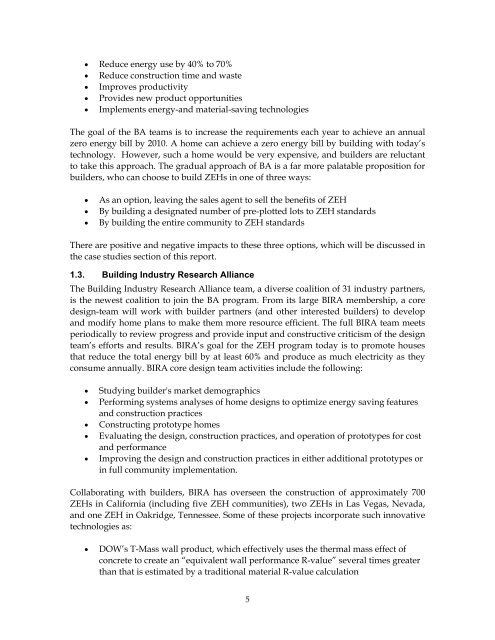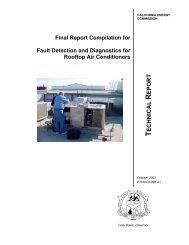design process study for the demonstration homes - Architectural ...
design process study for the demonstration homes - Architectural ...
design process study for the demonstration homes - Architectural ...
Create successful ePaper yourself
Turn your PDF publications into a flip-book with our unique Google optimized e-Paper software.
• Reduce energy use by 40% to 70%<br />
• Reduce construction time and waste<br />
• Improves productivity<br />
• Provides new product opportunities<br />
• Implements energy-and material-saving technologies<br />
The goal of <strong>the</strong> BA teams is to increase <strong>the</strong> requirements each year to achieve an annual<br />
zero energy bill by 2010. A home can achieve a zero energy bill by building with today’s<br />
technology. However, such a home would be very expensive, and builders are reluctant<br />
to take this approach. The gradual approach of BA is a far more palatable proposition <strong>for</strong><br />
builders, who can choose to build ZEHs in one of three ways:<br />
• As an option, leaving <strong>the</strong> sales agent to sell <strong>the</strong> benefits of ZEH<br />
• By building a <strong>design</strong>ated number of pre-plotted lots to ZEH standards<br />
• By building <strong>the</strong> entire community to ZEH standards<br />
There are positive and negative impacts to <strong>the</strong>se three options, which will be discussed in<br />
<strong>the</strong> case studies section of this report.<br />
1.3. Building Industry Research Alliance<br />
The Building Industry Research Alliance team, a diverse coalition of 31 industry partners,<br />
is <strong>the</strong> newest coalition to join <strong>the</strong> BA program. From its large BIRA membership, a core<br />
<strong>design</strong>-team will work with builder partners (and o<strong>the</strong>r interested builders) to develop<br />
and modify home plans to make <strong>the</strong>m more resource efficient. The full BIRA team meets<br />
periodically to review progress and provide input and constructive criticism of <strong>the</strong> <strong>design</strong><br />
team’s ef<strong>for</strong>ts and results. BIRA’s goal <strong>for</strong> <strong>the</strong> ZEH program today is to promote houses<br />
that reduce <strong>the</strong> total energy bill by at least 60% and produce as much electricity as <strong>the</strong>y<br />
consume annually. BIRA core <strong>design</strong> team activities include <strong>the</strong> following:<br />
• Studying builder's market demographics<br />
• Per<strong>for</strong>ming systems analyses of home <strong>design</strong>s to optimize energy saving features<br />
and construction practices<br />
• Constructing prototype <strong>homes</strong><br />
• Evaluating <strong>the</strong> <strong>design</strong>, construction practices, and operation of prototypes <strong>for</strong> cost<br />
and per<strong>for</strong>mance<br />
• Improving <strong>the</strong> <strong>design</strong> and construction practices in ei<strong>the</strong>r additional prototypes or<br />
in full community implementation.<br />
Collaborating with builders, BIRA has overseen <strong>the</strong> construction of approximately 700<br />
ZEHs in Cali<strong>for</strong>nia (including five ZEH communities), two ZEHs in Las Vegas, Nevada,<br />
and one ZEH in Oakridge, Tennessee. Some of <strong>the</strong>se projects incorporate such innovative<br />
technologies as:<br />
• DOW’s T-Mass wall product, which effectively uses <strong>the</strong> <strong>the</strong>rmal mass effect of<br />
concrete to create an “equivalent wall per<strong>for</strong>mance R-value” several times greater<br />
than that is estimated by a traditional material R-value calculation<br />
5








